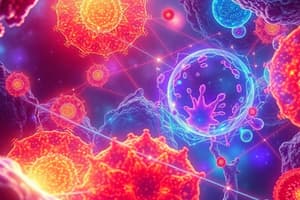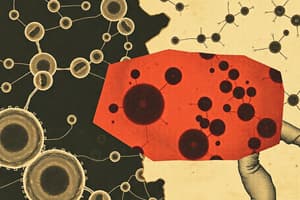Podcast
Questions and Answers
Which of the following best describes the central dogma of molecular biology?
Which of the following best describes the central dogma of molecular biology?
- Protein to DNA to RNA
- DNA to RNA to Protein (correct)
- Protein to RNA to DNA
- RNA to DNA to Protein
Which of the following did Schleiden and Schwann propose?
Which of the following did Schleiden and Schwann propose?
- Proposed the cell theory (correct)
- Described chromosome behavior during mitosis
- Discovered the Golgi apparatus
- Discovery of mitochondria
Based on modern cell theory, which statement is correct regarding the origin of cells?
Based on modern cell theory, which statement is correct regarding the origin of cells?
- Cells are created through the process of endosymbiosis.
- Cells can arise spontaneously from non-living matter.
- All cells come from pre-existing cells through cell division. (correct)
- Cells originate from the assembly of complex organic molecules.
Why is a high surface area-to-volume ratio important for cells?
Why is a high surface area-to-volume ratio important for cells?
Which of the following characteristics is typically associated with eukaryotic cells but not prokaryotic cells?
Which of the following characteristics is typically associated with eukaryotic cells but not prokaryotic cells?
What role do aminoacyl-tRNA synthetases play in the evolution of life?
What role do aminoacyl-tRNA synthetases play in the evolution of life?
Which of the following is a key difference between prokaryotic and eukaryotic gene expression?
Which of the following is a key difference between prokaryotic and eukaryotic gene expression?
Which of the following is an example of a cell function that is determined by gene expression?
Which of the following is an example of a cell function that is determined by gene expression?
Which of the following is a function of the Golgi apparatus?
Which of the following is a function of the Golgi apparatus?
What is the endosymbiotic theory primarily used to explain?
What is the endosymbiotic theory primarily used to explain?
Which statement accurately describes the relationship between genes and proteins?
Which statement accurately describes the relationship between genes and proteins?
Which of the following best describes the role of ribosomes?
Which of the following best describes the role of ribosomes?
Which of the following organelles is responsible for generating ATP through cellular respiration?
Which of the following organelles is responsible for generating ATP through cellular respiration?
What is the primary function of histones within a cell?
What is the primary function of histones within a cell?
Which scientist is credited with first describing cells in cork?
Which scientist is credited with first describing cells in cork?
Which of the following features is commonly found in prokaryotic cells?
Which of the following features is commonly found in prokaryotic cells?
Which of the following best describes the function of catabolic processes in cells?
Which of the following best describes the function of catabolic processes in cells?
What is the significance of the 'HeLa' cell line in cell biology?
What is the significance of the 'HeLa' cell line in cell biology?
How does alternative splicing contribute to proteomic diversity in eukaryotes?
How does alternative splicing contribute to proteomic diversity in eukaryotes?
What characteristic distinguishes anaerobic metabolism from aerobic metabolism?
What characteristic distinguishes anaerobic metabolism from aerobic metabolism?
Which scientist discovered, in 1857, lactobacillus bacteria which are also cells?
Which scientist discovered, in 1857, lactobacillus bacteria which are also cells?
What is the approximate size range of most bacteria?
What is the approximate size range of most bacteria?
What is the role of the enzyme reverse transcriptase in the context of early life and RNA?
What is the role of the enzyme reverse transcriptase in the context of early life and RNA?
What process did Rudolf Virchow describe in 1858?
What process did Rudolf Virchow describe in 1858?
How many genes approximately code E. coli as shown in the slides?
How many genes approximately code E. coli as shown in the slides?
Flashcards
What is a cell?
What is a cell?
The basic structural and functional unit of life. All known living things are made up of one or more cells.
Schleiden & Schwann
Schleiden & Schwann
Proposed that all organisms are composed of cells and that the cell is the fundamental unit of structure and function in living organisms.
Rudolf Virchow's cell theory
Rudolf Virchow's cell theory
Cells develop only from pre-existing cells. This is also known as the principle of cell division.
What are HeLa cells?
What are HeLa cells?
Signup and view all the flashcards
Modern Cell Theory
Modern Cell Theory
Signup and view all the flashcards
Main features of life
Main features of life
Signup and view all the flashcards
What does life involve?
What does life involve?
Signup and view all the flashcards
What is a prokaryote?
What is a prokaryote?
Signup and view all the flashcards
What is a eukaryote?
What is a eukaryote?
Signup and view all the flashcards
What is endosymbiotic theory?
What is endosymbiotic theory?
Signup and view all the flashcards
Endosymbiosis definition
Endosymbiosis definition
Signup and view all the flashcards
Surface area-to-volume ratio
Surface area-to-volume ratio
Signup and view all the flashcards
What are cell functions?
What are cell functions?
Signup and view all the flashcards
Genome
Genome
Signup and view all the flashcards
Gene Expression
Gene Expression
Signup and view all the flashcards
Alternative Splicing
Alternative Splicing
Signup and view all the flashcards
Introns
Introns
Signup and view all the flashcards
Exons
Exons
Signup and view all the flashcards
Catabolic
Catabolic
Signup and view all the flashcards
Anabolic
Anabolic
Signup and view all the flashcards
Chemosynthesis
Chemosynthesis
Signup and view all the flashcards
Photosynthesis
Photosynthesis
Signup and view all the flashcards
Glycolysis
Glycolysis
Signup and view all the flashcards
Oxidative phosphorylation
Oxidative phosphorylation
Signup and view all the flashcards
Genotype
Genotype
Signup and view all the flashcards
Phenotype
Phenotype
Signup and view all the flashcards
Study Notes
- Humans consist of about 37 trillion cells of 200 different types.
- Cell biology, anatomy, chemistry, biochemistry, biophysics, genetics, molecular biology, histology, physiology, and pathology are all important for medicine.
Cells as Basic Units
- Living organisms are either single cells or composed of cells.
- Striated muscle and giant algae are atypical occurrences of cells.
History of Cell Biology
- 1595: First light microscope (Jansen).
- 1655: Hooke observed 'cells' in cork.
- 1674: Leeuwenhoek observed protista (animalcules).
- 1833: Brown described the cell's nucleus from the orchid.
- 1839: Schleiden & Schwann proposed cell theory, stating all organisms are comprised of cells.
- 1857: Pasteur discovered lactobacillus, noting bacteria are also cells.
- 1858: Rudolf Virchow stated cells develop only from pre-existing cells via cell division (omnis cellula e cellula).
- 1859: Darwin's evolution theory was published in "The Origin of Species".
- 1866: Mendel became known as the Father of Genetics.
- 1874: Flemming described chromosome behavior during mitosis.
- 1882: Koch discovered Mycobacterium tuberculosis and established the pathogenic role of bacteria.
- 1894: Altmann first described mitochondria.
- 1898: Golgi described the Golgi apparatus.
- 1951: HeLa cells were discovered
- 2010: Creation of a bacterial cell was controlled by a chemically synthesized genome.
- Biophysical and molecular biology tools are now used for observation and manipulation.
Modern Cell Theory
- All known living things are made up of cells, which are their structural and functional units.
- All cells come from pre-existing cells by division, meaning spontaneous generation does not occur.
- Cells contain hereditary information, which is passed from cell to cell during cell division.
- Cells are similar in chemical composition.
- Cells maintain their organized structure by investing energy, with catabolic and anabolic processes occurring inside.
Origins and Features of Life
- The Miller experiment simulates conditions of early Earth to test the chemical origin of life.
- Main flow of information in cells moves from DNA to RNA protein.
- "Phenotype" is determined primarily by proteins.
RNA and Evolution
- Life involves enzyme-catalyzed anabolic and catabolic processes with self-reproduction.
- The RNA world likely preceded the protein world.
- RNA molecules can function as enzymes, such as RNA polymerase, and reverse transcriptase.
- By coupling RNA and protein synthesis via aminoacyl-tRNA synthetases, the universal genetic code evolved.
Prokaryotes
- Prokaryotes include archea and eubacteria.
- Prokaryotes have a nucleoid region instead of a nucleus.
- Prokaryotic DNA is circular and typically ranges from 0.75 to 5 Mbp.
- Prokaryotes usually lack introns.
- They have one chromosome, which is membrane-attached.
- They lack inner compartmentalization and a cytoskeleton.
- Prokaryotes do not have endocytosis or exocytosis.
Eukaryotes
- Eukaryotes include protists, yeast, plants, and animals.
- Eukaryotes have a nucleus, where RNA and protein synthesis are separated.
- They have a nucleolus and histones.
- Eukaryotic DNA is linear and 15 Mbp or more.
- Eukaryotes have introns in genes.
- They have multiple chromosomes and a nucleoskeleton.
- Eukaryotes possess mitochondria, chloroplasts, ER, Golgi, lysosomes, and peroxisomes.
- They have microtubules, microfilaments, and intermediate filaments,
- Endocytosis and exocytosis are present in eukaryotes.
Prokaryotes vs. Eukaryotes
- Prokaryotes have only a nucleoid, while eukaryotes have a nucleus.
- Prokaryotes lack introns, while eukaryotes have them.
- Transcription and translation occur in one compartment in prokaryotes but in separate compartments in eukaryotes.
- Prokaryotes lack intracellular membrane systems, mitochondria and phagocytosis.
- Eukaryotes have: intracellular membrane systems, mitochondria and phagocytosis
- Eukaryotic chromosomes are linear with telomeres, while prokaryotic chromosomes are not llinear.
Endosymbiotic Theory
- Mitochondria are thought to have descended from close relatives of typhus-causing bacteria via endosymbiosis.
- During evolution, a eukaryotic organism with adequate cytoskeleton and internal membrane systems engulfed/phagocytosed a prokaryotic organism, leading to a mutually beneficial relationship.
Evolution of Life
- Earth is 4.5 billion years old.
- Life arose on Earth 3.5-4 billion years ago.
- Prokaryotes and eukaryotes emerged 3 billion years ago.
- Plants, animals, and yeasts appeared 1.5 billion years ago.
- Early life forms used RNA.
- The nucleus evolved.
- Mitochondria developed.
- The evolution of life involves mutations, selection, and endosymbiosis.
Evolution Insights
- Main features of evolution of life on Earth:
- Prebiological evolution led to "organic soup" then RNA and DNA.
- Catalyzed chemical reactions, mutability, and selection are key with the self-reproductive capacity of traits.
- Compartmentalization, changes in leaps, and metabolism shifts are also important.
- E. coli divides every 20-40 minutes.
Cell Size and Function
- Cells need to have a large surface area-to-volume ratio.
- Cell functions include self-maintenance, motility, growth, proliferation, cell-cell communication, differentiation, and morphogenesis, all determined by gene expression.
Genes
- Mycoplasma has ~300 genes.
- E. coli has ~4000 genes.
- Yeast has ~6000 genes.
- C. elegans has ~20000 genes.
- Humans have ~20000 or more genes.
Genome Size
- E. coli has a genome size of ~5 million base pairs.
- Yeast has a genome size of ~12 million base pairs.
- C. elegans has a genome size of ~100 million base pairs.
- Humans have a genome size of ~3000 million base pairs.
Gene Expression: Prokaryotes vs. Eukaryotes
- In prokaryotes, transcription and translation occur simultaneously.
- In eukaryotes, transcription occurs in the nucleus, and translation occurs in the cytosol.
- Eukaryotic genes contain introns that are removed during RNA processing.
- Eukaryotic mRNA undergoes splicing and export.
- Alternative splicing allows more proteins than genes.
Why More DNA?
- Humans have 30x more DNA than C. elegans, but about the same number of genes.
- Gene expression regulation in eukaryotes includes protein factors, RNAs, lncRNAs (long non-coding RNA), miRNAs (micro RNA), and circular RNAs.
Cell Dimensions
- Cell membrane: 4-10 nm.
- Average protein: 3-6 nm.
- Water molecule: 0.3 nm.
Important Molecule Dimensions
- Water molecule: 0.3 nm.
- DNA diameter: 2 nm.
- Average protein: 3-6 nm.
- Cell membrane thickness: 7 nm.
- HIV virus diameter: 100 nm.
- Protozoan length: 25 μm.
- Human red blood cell diameter: 7-8 μm.
- Bacterium diameter: 1-5 μm.
- Average cell diameter: 10-20 μm.
- Neurite length: <1.5 meter
- Average cell volume: 100-10000 μm³.
Questions to Consider
- Do plants have mitochondria?
- Which organelles originated by endosymbiosis?
- Do bacteria have ribosomes?
- What are introns and exons?
Revisions
- Know the size range of relevant organic entities.
- Know the approximate volume, time, speed and concentration ranges of biologically relevant items/processes.
Studying That Suits You
Use AI to generate personalized quizzes and flashcards to suit your learning preferences.





